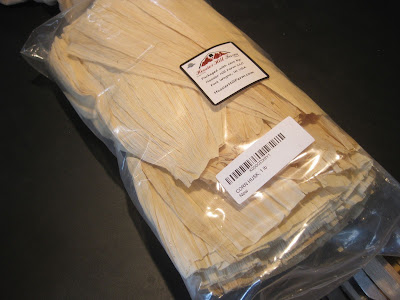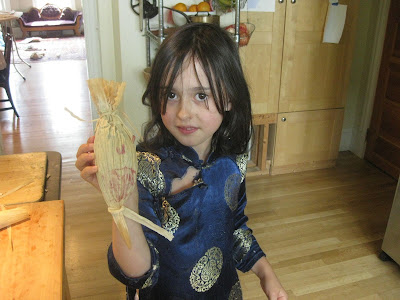I put together two more copies of the super simple A line dress patterns for the girls, and we dyed them using black beans.
The fabric, construction, and seam finishing is the same as in the previous post on the A line dresses, but I did drop the hem about 10cm and bring in the side seams a little on Violet's dress. To tell you the truth I'm not completely loving how this A line pattern looks; it is very sack-like. But it is extremely fast and easy to do, which is a plus. On these I used white #30 Tire silk thread throughout, rather than the junk thread I used on the muslins.
Lately I've been thinking about dyeing of fabric. Here is the vision that I find enticing: Stock undyed bolts of a select few types of fabric, in wovens perhaps a wool, a cotton or cotton/linen, and a silk, and one roll of jersey knit in cotton. Dye fabric off these bolts as needed to make clothes. Doesn't that sound simple, but profoundly powerful and adaptable? Sure, it is nice to luxuriate in the bounty that is the modern textile industry, with zillions of combinations of fiber blends, weaves, and colors. But I think that contributes to the fabric stash build up problem; you see something interesting and buy it to have in your stash, only to neglect it later since its not exactly what you want for the project you are working on. It is also tiring to have to shop for the right combination of features in a fabric. It could be more straightforward to lay in a stock of high quality fabric you are happy with, then set the color later as part of the sewing project itself. I think I could be quite happy with a basic palette of colors on good fabric.
With dying on my mind, I dug out a book on natural fabric dyeing that Becky bought like 10 years ago, called Wild Color, by Jenny Dean. At the time I made a lot of fun of her for buying this book, teasing her that most of the colors you can get from natural materials look like shades of barf. Now that I am poring over this book nightly, she is relishing how the tables have turned! Natural dying seems more interesting than synthetic since it is easier for the kids to see where the dyestuff comes from and allows us to get more deeply involved in the process, especially if we can grow, forage, or otherwise source the raw materials and extract the dye ourselves.
To experiment with having a dyer's garden, we planted a few dye plants. The Japanese Indigo seeds appear to have been unviable or maybe I just not a great gardener, in any case they didn't come up. I'm pretty sure this is the woad I planted though:
Woad makes the same molecule as indigo, but at a lower concentration.
 |
| Indigo |
I put in a small patch of Madder, which is doing well so far. In 5 years or so, I should be ready to dig up the roots and use them to make an excellent red dye bath.
I read online about dyeing with black bean water. The color it makes is a grayish-blue, one of my personal favorite color ranges. The raw inputs are cheap and easy to get, and you can eat them afterwards. I did come across some sources that said it was not particularly fast as a color, but I figured I could always redye the dresses later if the color didn't last.
The first step was to mordant the dresses. I read in Wild Color that vegetable fibers are harder to dye than animal fibers, but this could be partly made up by doing some extra work in the mordanting phase.
The book recommended a tannin treatment before the alum mordanting I was already planning on. One of the sources of tannin listed in the book is Staghorn Sumac, apparently very widespread and super high in tannin. I looked up how to identify this plant online, then kept an eye out for it. It's amazing how once you are attuned to look for something, you start seeing it everywhere, even though before you never noticed it. Well, I can report that there is a ton of Staghorn Sumac growing along the bike path I commute to work on.
Sumac is generally shrub sized, grows in clumps, has a large compound pinnate leaf, and upward facing cones of tiny flowers in the summer.
The Staghorn variety can be identified by the fuzz on the stem of new growth.
And by the jagged edges all the way around the leaves.
The girls took turns rolling down a grassy hill nearby.
The next day, Millie cut all the leaves in half and loaded them into the strainer of a stainless pot I got just for use in dyeing. My friend Helen was visiting, so she, Child 1, and Violet helped.
The pot was pretty full with sumac leaves when we filled it with water. It was boiled on the stove for about an hour, then left to cool down through the afternoon.
Meanwhile, we put 2.2kg of Goya black beans into a pot.
and covered with about 15L of water.
When the boiled sumac broth was cool, we strained out the boiled leaves.
Then added the dresses
and a few other test pieces, about 300g of fabric altogether.
This was left to sit until the next day, then removed. The fabric was squeezed out and run through a cold rinse cycle in the washing machine. It had picked up a greenish-gray cast, you might say a light-ish barf color.
Next, we put a 1/4 cup of alum and 1/8 cup of washing soda into about 10 liters of boiling water. It didn't fully dissolve, but we filled the rest of the pot with cool water and added the rinsed fabric. This was brought to a simmer, then allowed to sit overnight.
We also siphoned off the black bean water into a bucket.
Apparently it is detrimental to get the slime and proteins down close to the beans, so we just only siphoned the liquid until it was down to about 10mm above the beans. Then the beans were strained, packed in bags, and frozen. We ended up using about half of these beans in tamales.
The next day, the fabric was removed from the alum bath and run through another cold water rinse in the washer. Then finally the goods went into the dye
then sat there for the next two days, with the occasional stir.
On removal, we once more rinsed them in the washing machine. What a lovely color they came out! This is what they looked like wet.
The piece on the left is silk charmeuse, the ribbon is bias cut silk habotai, and the coupons near the bottom right are wool. The wool didn't really take the color at all, the cotton/linen worked nicely, and the silk took the deepest color. Millie had recently been digging around the ribbon box and asked if I would make her something with this polka dot ribbon, so it is layed out here so I could get a first impression of how it would look on the dresses.
I hung them up to dry. Later on, I made some flowers by folding a strip of silk charmeuse in half, then gradually rolling it up while stitching together the bottom edge and putting in some foldbacks and gathers.
The polka dot ribbon and buttons were put on
and the dresses were ready to wear.
We went to a little fun fair then watched fireworks in Lexington on July 3rd, and the girls wore their dresses for the first time.
The dresses got washed (I think in cold water) with our regular laundry soap, and came out very faded. I think maybe the enzymes in the soap attacked the dye. Now they are trending toward that subtle vomit color I mentioned above, kind of a light tan-gray-green. Too bad, the color was really nice! Ah well, we had fun doing this project and maybe at some point I can take the trim off and lightly overdye them with indigo.









































































